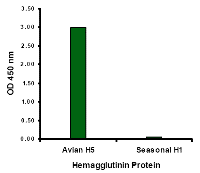Catalog# : PM-4006
Influenza A virus is a major public health threat, killing more than 30,000 people per year in the USA (1). Novel influenza virus strains caused by genetic drift and viral recombination emerge periodically to which humans have little or no immunity, resulting in devastating pandemics. Influenza A can exist in a variety of animals; however it is in birds that all subtypes can be found (2). These subtypes are classified based on the combination of the virus coat glycoproteins hemagglutinin (HA) and neuraminidase (NA) subtypes. During 1997, an H5N1 avian influenza virus was determined to be the cause of death in 6 of 18 infected patients in Hong Kong (3). The more recent virulent strain of H5N1 is now seen in Africa and Europe, as well as in southeast Asia. There is some evidence of human to human spread of this virus, but it is thought that the transmission efficiency was fairly low (4). HA interacts with cell surface proteins containing oligosaccharides with terminal sialyl residues. Virus isolated from a human infected with the H5N1 strain in 1997 could bind to oligosaccharides from human as well as avian sources, indicating its species-jumping ability (5). While efforts were made to use relatively conserved regions of the viral sequence as the antigen, the influenza virus genome has drifted somewhat from what was first reported. However, this antibody was able to recognize peptides derrived from viruses from Indonesian human patients infected in 2007.
Additional Names : Avian Influenza A (H5N1) Hemagglutinin (4H1C10), H5N1 Hemagglutinin
 Description
DescriptionLeft: Hemagglutinin antibody at 2 µg/ml specifically recognizes Avian H5N1 influenza virus but not seasonal influenza virus A H1N1 Hemagglutinin protein.
Source : Mouse monoclonal Hemagglutinin antibody was raised against a synthetic peptide corresponding to 14 amino acids in the middle of the Hemagglutinin protein. This sequence is identical to the immunogen of the polyclonal Hemagglutin antibody, catalog number 3425.
Purification : Immunoaffinity chromotography purified IgG
Clonality and Clone : This is a monoclonal antibody. (Clone 4H1C10)
Host : Hemagglutinin monoclonal antibody was raised in mouse. Please use anti-rabbit secondary antibodies.
Immunogen : A peptide corresponding to synthetic peptide corresponding to 14 amino acids in the middle of Hemagglutinin.
Application : Hemagglutinin antibody can be used for the detection of the Hemagglutinin protein from the H5N1 strain of avian influenza A in ELISA. (Optimal dilution should be determined by user.) It will detect 10 ng of free peptide at 1 µg/ml. Other applications are pending.
Tested Application(s) : E
Buffer : Antibody is supplied in PBS containing 0.02% sodium azide.
Blocking Peptide :
Long-Term Storage : Hemagglutinin monoclonal antibody can be stored at 4ºC, stable for one year.
Species Reactivity :V
Short Description : Avian Influenza Hemagglutinin (4H1C10)
References
1. Thompson WW, Shay DK, Weintraub, et al. Mortality associated with influenza and respiratory syncytial virus in the United States. JAMA 2003; 289:179-186.
2. Alexander DJ. A review of avian influenza. Proceedings of the European Society for Veterinary Virology (ESVV) Symposium on Influenza Viruses of Wild and Domestic Animals. Vet. Microbiol. 2000; 74:3-13.
3. Shortridge KF, Zhou NN, Guan Y, et al. Characterization of avian H5N1 influenza viruses from poultry in Hong Kong. Virol. 1998; 252:331-342.
4. Buxton Bridges C, Katz JM, Seto WH, et al. Risk of influenza A (H5N1) infection among health care workers exposed to patients with influenza A (H5N1), Hong Kong. J. Inf. Dis. 2000; 181:344-8.

No comments:
Post a Comment